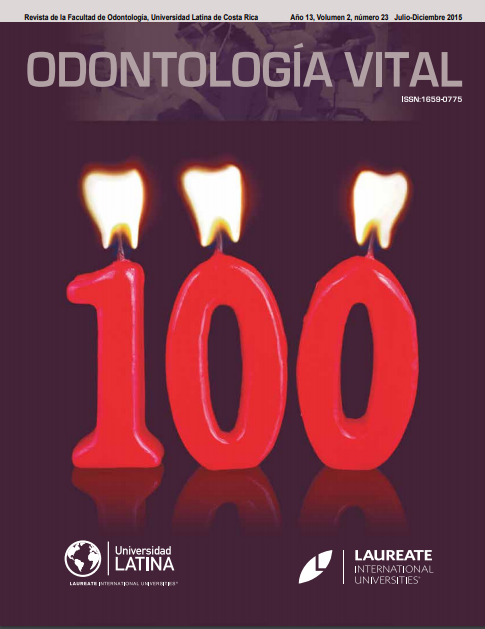Caries risk factors in pregnant women beneficiaries of primary health centers the Commune of Quillota and Calera, Chile: cross sectional study.
DOI:
https://doi.org/10.59334/ROV.v2i23.267Keywords:
Caries, pregnancy, mutans streptococci, lactobacilliAbstract
The high prevalence of caries in pregnant and study of risk factors are of importance in public health. The aim of this study is to identify factors that may be associated with higher caries prevalence in pregnant, beneficiaries of primary health centers in the district of Quillota and Calera.
Methods: A cross sectional study, 217 pregnant, who evaluated; sociodemographic factors and health factors through a self-administered questionnaire, caries experience with decayed index (DMFT); oral hygiene index, presence of streptococcus mutans and lactobacilli in saliva, saliva buffer capacity and frequency of food consumption. The study was approved by the Bioethics Committee of the Faculty of Medicine of the University of Chile and has reported for participants consent.
Results: of the 217 patients 55% had caries, with DMFT index of 8,60 95% CI [7.32: 8.89]. Risk factors that present significant for mean differences DMFT were age, condition multiparous, low buffering capacity of saliva, mothers without paid work and had lost teeth last year (p <0.05).
Conclusions: This study shows a high prevalence of caries in the pregnant group, associated with socioeconomic factors (such as paid work mother) and biological factors such as buffering capacity of saliva.
Downloads
References
Análisis de situación de salud bucal 2012, MMINSAL
Berkowitz, R.J., (2006) Mutans streptococci: acquisition and transmission. Pediatr Dent. 28(2): p. 106-9; discussion 192-8.
Bogges K.A., B.L., (2006) Oral Health in women during preconception and pregnancy: Implications for Birth Outcomes and infant oral health. Matern Child Health J. 10: p. S169-S174. https://doi.org/10.1007/s10995-006-0095-x
Burt, B. A. (2002). “Fluoridation and social equity.” J Public Health Dent 62(4): 195-200. https://doi.org/10.1111/j.1752-7325.2002.tb03445.x
Caufield, P.W., G.R. (1993) Cutter, and A.P. Dasanayake, Initial acquisition of mutans streptococci by infants: evidence for a discrete window of infectivity. J Dent Res. 72(1): p. 37-45. https://doi.org/10.1177/00220345930720010501
Laine, M. A. (2002). “Effect of pregnancy on periodontal and dental health.” Acta Odontol Scand 60(5): 257-264. https://doi.org/10.1080/00016350260248210
Lim, S., W. Sohn, et al. (2008). “Cariogenicity of soft drinks, milk and fruit juice in low-income african-american children: a longitudinal study.” J Am Dent Assoc 139(7): 959-967; quiz 995. https://doi.org/10.14219/jada.archive.2008.0283
Marsh, P.D., (1994) Microbial ecology of dental plaque and its significance in health and disease. Adv Dent Res, 8(2): p. 263-71. https://doi.org/10.1177/08959374940080022001
Moncada G., I. U., Ed. (2008). Cariología clínica Bases preventivas y Restauradoras Capitulo 3. Factores de riesgo de la actividad cariogénica en la dinámica clínica del proceso de caries. Santi ago
Nyvad, B., et al., (2013) Dental caries from a molecular microbiological perspective. Caries Res. 47(2): p. 89-102. https://doi.org/10.1159/000345367
Perez A., B.M., Espeso N., Miranda M., Gonzalez B., (2011) Caries dental asociado a factores de riesgo durante el embarazo. Rev. Cubana de Estomatología, 48(2): p. 104-112.
Petersen, P. E. (2003). “The World Oral Health Report 2003: continuous improvement of oral health in the 21st century--the approach of the WHO Global Oral Health Programme.” Community Dent Oral Epidemiol 31 Suppl 1: 3-23. https://doi.org/10.1046/j..2003.com122.x
Ribeiro, N.M. and M.A. Ribeiro, (2004) [Breastfeeding and early childhood caries: a critical review]. J Pediatr (Rio J). 80(5 Suppl): p. S199-210. https://doi.org/10.1590/S0021-75572004000700012
Silk, H., et al., (2008) Oral health during pregnancy. Am Fam Physician, 77(8): p. 1139-44.
Takahashi, N. and B. Nyvad, (2008) Caries ecology revisited: microbial dynamics and the caries process. Caries Res,. 42(6): p. 409-18. https://doi.org/10.1159/000159604
Takahashi, N. and B. Nyvad (2011). “The role of bacteria in the caries process: ecological perspectives.” J Dent Res 90(3): 294-303. https://doi.org/10.1177/0022034510379602
Takahashi, N. and B. Nyvad, (2011) The role of bacteria in the caries process: ecological perspectives. J Dent Res. 90(3): p. 294-303. https://doi.org/10.1177/0022034510379602
Vergnes, J.N., et al., (2012) Frequency and risk indicators of tooth decay among pregnant women in France: a cross-sectional analysis. PLoS One,.7(5): p. e33296. https://doi.org/10.1371/journal.pone.0033296
Villagrán, E., A. Linossier, et al. (1999). “[Co unt of salivary Streptococci mutans in pregnant women of the metropolitan region of Chile: cross-sectional study].” Rev Med Chil 127(2): 165-170. https://doi.org/10.4067/S0034-98871999001200007
Downloads
Published
Issue
Section
License
Copyright (c) 2015 Vezna Sabando Franulic

This work is licensed under a Creative Commons Attribution 4.0 International License.
Authors who publish with Odontología Vital agree to the following terms:
- Authors retain the copyright and grant Universidad Latina de Costa Rica the right of first publication, with the work simultaneously licensed under a Creative Commons Attribution 4.0 International license (CC BY 4.0) that allows others to share the work with an acknowledgement of the work's authorship and initial publication in this journal.
- Authors are able to enter into separate, additional contractual arrangements for the non-exclusive distribution of the Odontología Vital's published version of the work (e.g., post it to an institutional repository or publish it in a book), with an acknowledgement of its initial publication.
- Authors are permitted and encouraged to post their work online (e.g., in institutional repositories or on their website) prior to and during the submission process, as it can lead to productive exchanges, as well as earlier and greater citation of published work.







